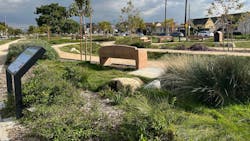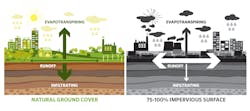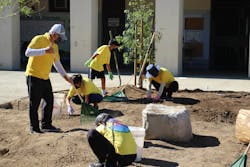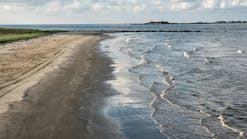LA County program supports multi-benefit stormwater infrastructure projects
An urban orchard with a nature-based playground and education garden. A living schoolyard that reduces air pollution and heat by replacing asphalt with vegetation, trees and a rain garden. A green street that combines stormwater management strategies with natural habitat and public health benefits. By funding these projects and others like them, Los Angeles County is embracing a multi-benefit approach to stormwater management.
LA County’s voter-approved Safe Clean Water Program (SCWP) aims to improve water quality, enhance water supplies, improve public health, and provide community investment benefits, with a particular focus on disadvantaged communities. The SCWP is funded through a parcel tax that generates approximately $280 million annually in perpetuity. The program disperses funds into three pots: 10% to the District Program for administration and capacity building; 40% to fund stormwater projects in cities throughout the county on a per capita basis; and 50% distributed through grants under the Regional Program.
Three years post-inception, the Regional Program has already directed $1 billion (including leveraged funding) to more than 100 multi-benefit stormwater infrastructure projects as well as to provide technical assistance and studies for future projects.
The SCWP was designed to be adapted and refined over time, with a robust structure of community engagement. The program has the potential to dramatically remake LA’s approach to stormwater management and is a model for other counties and municipalities.
LA County’s Water System
LA’s water system faces numerous overlapping problems. Urban and stormwater runoff contribute heavy loads of pollution (bacteria, heavy metals, oil, trash, and “forever chemicals”) to waterways. Meanwhile, LA is a water scarce region, over-reliant on expensive, increasingly limited imported water sources. Looming over the whole system are the impacts of climate change, on full display this winter as drought-ravaged California faced multiple parades of atmospheric rivers.
One of the key factors contributing to LA County’s stormwater challenges is the degree to which natural greenspace has been replaced by hardscape in much of the region. While the U.S. on average has 10 acres of public parkland per 1000 people, LA has only 3.3 acres per 1000 residents. Streets, channelized and concrete-lined rivers and creeks, and storm drains all funnel pollutants into the ocean. These impervious surfaces block natural stormwater infiltration that recharges groundwater basins. Also, more hardscape means fewer greenspaces (which support community health and well-being), intensified heat island effect and increased air pollution for Angelenos.
The SCWP’s Regional Program
As this wet winter has demonstrated, the Los Angeles region needs a robust program to manage its stormwater challenges. In 2018, LA County voters overwhelmingly approved Measure W to fund multi-benefit stormwater infrastructure. This measure established the basic structure of the SCWP.
The grant-based Regional Program has completed allocating its third round of funds. To date, more than $700M of Measure W funds have been earmarked through these grants. Matching funds from other local, state and federal entities raise the total to more than $1B. This funding will support the development, construction, operations and maintenance of 101 multi-benefit stormwater infrastructure projects, as well as technical support for proposed projects, scientific studies and staff to assist with community outreach and program development.
The funded projects provide community benefits by doing things like adding climate-appropriate vegetation, rehabilitating parks, and greeningschoolyards. At Jackson Elementary School in the Upper Los Angeles River watershed, the SCWP funded a project to replace 60% of the school’s asphalt with rain gardens, bioswales, and permeable pavement and to plant vegetation. This multi-benefit project minimizes and filters stormwater runoff while improving air quality, reducing heat, mitigating carbon emissions, and improving the emotional health of students and community members. The school district and a local environmental justice group created this “living schoolyard” by collaborating closely with students, parents, teachers, staff and the surrounding community.
How the Program Works
SCWP Regional Program funding is awarded through a competitive grant process, allocating funds among the nine watersheds in LA County, consistent with the revenues generated within each watershed. A Watershed Area Steering Committee (WASC) in each watershed evaluates project applications that meet a minimum scoring threshold. Each WASC submits their recommendations to the Regional Oversight Committee (ROC) for review, then to the county Board of Supervisors for final approval. The whole process, from application to approval, takes upwards of a year.
Proposals are evaluated for traditional elements such as stormwater capture and infiltration/recharge benefits, and for community-oriented elements like nature-based solutions (hardscape removal, school greening), community investment, community engagement and support, and benefits to disadvantaged communities. Biennial reviews, required under Measure W, are led by the ROC and presented to the Board of Supervisors. This process serves as a mechanism for iterative improvement. The first such review is currently underway.
Room for Improvement
The SCWP has accomplished much in its first three years. Not surprisingly, given the program’s broad scope and ambition, there are also clear opportunities for improvement. Los Angeles Waterkeeper, a non-profit organization that fights for the health of the LA region’s waterways and for sustainable, equitable, and climate resilient water supplies, assessed the SCWP’s Regional Program in a recently released report, “Changing the Course?: What’s Worked, What Hasn’t, and What’s Next for the SCWP.”i The assessment found the program has been effective in rolling out funding for major infrastructure projects that will provide significant water quality benefits by collecting and treating contaminated runoff. Funded projects will also increase the opportunity for LA County to rely more on captured stormwater as part of its water supply portfolio.
The assessment also suggested improvements that will increase the SCWP’s effectiveness and allow it to deliver on its full promise. LA Waterkeeper calls on LA County, in consultation with other stakeholders and with robust community input, to develop a proactive vision identifying the best opportunities for high impact stormwater capture and treatment projects and where such projects should be built. The report also flagged an urgent need to greatly accelerate the replacement of hardscape with greenspace, particularly at schools and in park-poor communities; to prioritize projects in disadvantaged communities; and to increase community engagement.
Developing specific metrics for the community-oriented program elements (e.g., nature-based solutions, community investment), developing a watershed-specific project evaluation process that accounts for different soil types and relative greenspace, and providing better support for smaller, community-driven project applicants would further strengthen the program.
The East Los Angeles Sustainable Median Stormwater Capture Project is a good example of a completed SCWP project that delivers both traditional elements of stormwater projects and more community-oriented elements. This project, in a frontline community in the Rio Hondo Watershed, leveraged $22.5 million (with an additional $7 million through the SCWP) to build stormwater capture infrastructure that infiltrates 378 million gallons of water annually for water supply. The street median incorporates infiltration wells and bioswales with drought tolerant landscaping, jogging paths, educational signage, and more than 300 trees to provide shade and reduce the heat island effect.
Nature-Based Solutions Bring Wide-Reaching Community Benefits
Another project funded by the SCWP is Urban Orchard in the Lower Los Angeles River watershed. Currently, only 3% of the land in the city of South Gate is greenspace and 20% of the residents have incomes below the federal poverty threshold. Thanks to SCWP funding, a barren expanse of postindustrial land in this frontline community is being transformed into a vibrant neighborhood park. A grove of 200 fruit trees will create shade and contribute fresh produce to the community. A nature-based playground will incorporate a mural highlighting the history of the local indigenous Tribe, the Tongva people. Also included are walking paths, native plants, an education garden, wetlands, and habitat for native fish, migratory birds, and pollinators. The project, which incorporates community-driven designs, will create opportunities for exercise and recreation, reduce air pollution, and provide 30 long-term, local jobs for underserved youth. Meanwhile, the wetlands will capture and filter 32 million gallons of stormwater annually for reuse on site.
The track record to date of the SCWP clearly demonstrates the vital need to fund stormwater infrastructure projects. LA County’s model stormwater capture program demonstrates that a multi-benefit approach can do far more than just increase local stormwater capture. A well-designed program can influence a region’s character by funding projects with far-reaching community benefits such as green schoolyards and public parks, and by engaging community members in enhancing local access to clean, abundant water.
Bruce Reznik is Executive Director and Maggie Gardner is Science & Policy Manager at Los Angeles Waterkeeper, a non-profit that has served as LA’s water watchdog since 1993, fighting for the health of the region’s waterways, and for sustainable, equitable, and climate-resilient water supplies. LA Waterkeeper was integrally involved in the development of Measure W and continues to be engaged in the implementation of the Safe Clean Water Program.
Bruce Reznik | Executive Director
Bruce Reznik is Executive Director at Los Angeles Waterkeeper, a non-profit that has served as LA’s water watchdog since 1993, fighting for the health of the region’s waterways, and for sustainable, equitable, and climate-resilient water supplies. LA Waterkeeper was integrally involved in the development of Measure W and continues to be engaged in the implementation of the Safe Clean Water Program.
Maggie Gardner | Science & Policy Manager
Maggie Gardner is Science & Policy Manager at Los Angeles Waterkeeper, a non-profit that has served as LA’s water watchdog since 1993, fighting for the health of the region’s waterways, and for sustainable, equitable, and climate-resilient water supplies. LA Waterkeeper was integrally involved in the development of Measure W and continues to be engaged in the implementation of the Safe Clean Water Program.









